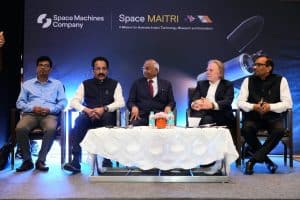Established in 1958, JETRO or the Japan External Trade Organization, promotes trade and investment relations between Japan and other countries, facilitating the country’s enterprises to seek markets abroad, attracting FDI, and forging tie-ups and cooperation. In India, the organization looks at boosting trade collaboration between the two countries.
“Together both India and Japan can explore opportunities for collaboration in core technologies, services, and applications. Geospatial and space hold a lot of promise, and sky is literally the limit”, says Takashi Suzuki, Chief Director General, JETRO South Asia.
Trade between India and Japan has been quite strong with automobiles, digital technologies, and consumer electronic appliances being the mainstay. What do you think is the future of the evolving trade relationship between the two strong Asian democracies?
Since the late eighties, the Japanese automotive industry enjoys the opportunities in India market. But, now almost after half century, we need more diversification of Japanese business in India.
One of the biggest challenges that we face is inviting newcomers from different sectors. In the space and geospatial sectors, there’s a lot of possibility for growing collaboration between the two countries. We would like to focus on fostering greater cooperation in these sectors.
India and Japan are two leading spacefaring nations. How do you think the both of their ambitions can be mutually synergized?
When we look at the history of these two countries and their bilateral relations, there’s a lot of scope for exclusive relationships in specific sectors. Space and geospatial services sector holds the potential to be the most important area of collaboration.
However, due to the prevailing geospatial scenario and the restrictions on free trade, free exchange of investments and capital, things tend to get difficult.
India is among the powerhouses when it comes to information technology, manpower, infrastructure, and services. While Japan is renowned for digital technologies and immersive solutions. How can both countries join forces for advancing cutting-edge future fourth-industrial revolution technologies?
Indian Prime Minister Narendra Modi said something similar to Indian software and Japanese hardware together creating wonders. But honestly, this is not happening. So there is a need to put in more efforts.
While Indo-Japan ties are quite old and strong, with presence of Indian companies in Japan, and vice-versa. But compared to Japan-Thailand, Japan-Indonesia, or Japan-US relations, there’s still a long way to go. There’s a need of broader talent and people-to-people exchange between the two countries.
What do you think are some of the key challenges in deepening trade collaboration between New Delhi and Tokyo?
It is our common understanding that, government dialogues and involvement of the private sector will play a crucial role. That said, on our side we have certain export restrictions, and on the Indian side, owing to the current geopolitical scenario, I feel, there’s a certain degree of protectionism.
Nonetheless, a lot is happening and as we move forward, step by step, more deeper collaboration will only pick up pace.
Do you think there’s a need for a common framework for mutual technology transfer because it usually involves a lot of skepticism?
Yes, niche technologies tend to be closely guarded. That’s why we need broader government-to-government dialogues with the active involvement of the private sector and all other stakeholders.
This would help in identifying key opportunity areas, and join hands to work on some projects or other emerging areas, or look for avenues for sustained collaboration.









